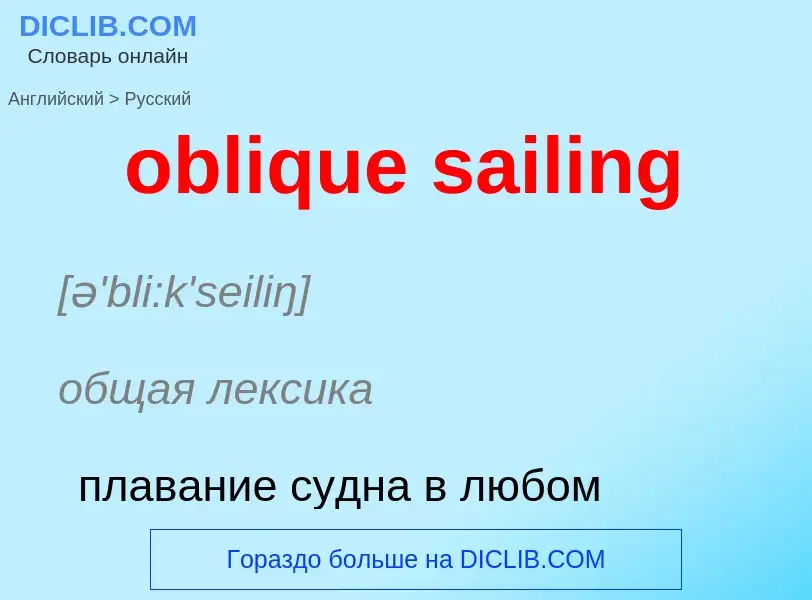Перевод и анализ слов искусственным интеллектом ChatGPT
На этой странице Вы можете получить подробный анализ слова или словосочетания, произведенный с помощью лучшей на сегодняшний день технологии искусственного интеллекта:
- как употребляется слово
- частота употребления
- используется оно чаще в устной или письменной речи
- варианты перевода слова
- примеры употребления (несколько фраз с переводом)
- этимология
oblique sailing - перевод на русский
[ə'bli:k'seiliŋ]
общая лексика
плавание судна в любом направлении
не совпадающем со сторонами света
['seiliŋ|ʃip-{'seiliŋ}ves(ə)l]
существительное
общая лексика
парусное судно
парусник
парусное судно, парусник
медицина
косая черпаловидная мышца
['seiliŋ]
общая лексика
парусный
рейс
прилагательное
общая лексика
парусный
относящийся к рейду корабля
существительное
общая лексика
плавание
мореплавание
кораблевождение
навигация
отплытие
отход (судна)
отходящие суда
расписание отхода судов
парусный спорт
мореходство
отход, отплытие
устаревшее выражение
плавание под парусами
авиация
парение
планирование
дрейф (гидросамолёта на воде)
Википедия
.jpg?width=120)
An oblique shock wave is a shock wave that, unlike a normal shock, is inclined with respect to the incident upstream flow direction. It will occur when a supersonic flow encounters a corner that effectively turns the flow into itself and compresses. The upstream streamlines are uniformly deflected after the shock wave. The most common way to produce an oblique shock wave is to place a wedge into supersonic, compressible flow. Similar to a normal shock wave, the oblique shock wave consists of a very thin region across which nearly discontinuous changes in the thermodynamic properties of a gas occur. While the upstream and downstream flow directions are unchanged across a normal shock, they are different for flow across an oblique shock wave.
It is always possible to convert an oblique shock into a normal shock by a Galilean transformation.

.jpg?width=200)
![[[Concorde]] intake ramp system [[Concorde]] intake ramp system](https://commons.wikimedia.org/wiki/Special:FilePath/Concorde Ramp.jpg?width=200)


![Austronesian vessel]] with [[outrigger]]s and a [[fore-and-aft]] sail Austronesian vessel]] with [[outrigger]]s and a [[fore-and-aft]] sail](https://commons.wikimedia.org/wiki/Special:FilePath/Atlas pittoresque pl 096.jpg?width=200)
![lateen rig]] lateen rig]]](https://commons.wikimedia.org/wiki/Special:FilePath/Bgl3t.jpg?width=200)


![[[Schooner]]s became favored for some coast-wise commerce after 1850—they enabled a small crew to handle sails. [[Schooner]]s became favored for some coast-wise commerce after 1850—they enabled a small crew to handle sails.](https://commons.wikimedia.org/wiki/Special:FilePath/FMIB 37320 Schooner Sept-Mats nord-americain.jpeg?width=200)
![1798 sea battle between a French and British [[man-of-war]] 1798 sea battle between a French and British [[man-of-war]]](https://commons.wikimedia.org/wiki/Special:FilePath/H.M.S. Mars and the French '74 Hercule off Brest, 21st April 1798.jpg?width=200)
 - SLV H99.220-2856.jpg?width=200)
![Victoria]]'', which completed the first global circumnavigation. Victoria]]'', which completed the first global circumnavigation.](https://commons.wikimedia.org/wiki/Special:FilePath/Nao Victoria.jpg?width=200)
![ship]] ship]]](https://commons.wikimedia.org/wiki/Special:FilePath/Portrait of an American Clipper Ship.jpeg?width=200)



, body plan.jpg?width=200)


![[[18ft Skiff]], flying a sprit-mounted asymmetrical spinnaker on a broad reach [[18ft Skiff]], flying a sprit-mounted asymmetrical spinnaker on a broad reach](https://commons.wikimedia.org/wiki/Special:FilePath/18foot skiff Kiel2008.jpg?width=200)

![Plymouth]], England in the 2015 Rolex Transatlantic Race Plymouth]], England in the 2015 Rolex Transatlantic Race](https://commons.wikimedia.org/wiki/Special:FilePath/Comanche in the Rolex Transatlantic Race 2015 leaving Newport RI for Plymouth England--B.jpg?width=200)
![Contender]] dinghy trimmed for a reach with the sail aligned with the apparent wind and the crew providing moveable ballast to promote planing Contender]] dinghy trimmed for a reach with the sail aligned with the apparent wind and the crew providing moveable ballast to promote planing](https://commons.wikimedia.org/wiki/Special:FilePath/Contender sailing dinghy.jpg?width=200)
![The [[ocean current]]s The [[ocean current]]s](https://commons.wikimedia.org/wiki/Special:FilePath/Corrientes-oceanicas.png?width=200)
![A French squadron forming a [[line of battle]] circa 1840. A French squadron forming a [[line of battle]] circa 1840.](https://commons.wikimedia.org/wiki/Special:FilePath/La Marine-Pacini-140.png?width=200)

 and down wind (left).jpg?width=200)


![Cruising sailing yacht at anchor in Duck Harbor on [[Isle au Haut, Maine]] Cruising sailing yacht at anchor in Duck Harbor on [[Isle au Haut, Maine]]](https://commons.wikimedia.org/wiki/Special:FilePath/Sailing yacht anchored in Duck Harbor Maine July 2012.jpg?width=200)
![Santa María]]'' under sail Santa María]]'' under sail](https://commons.wikimedia.org/wiki/Special:FilePath/SantaMaria.jpg?width=200)
![Boats heeling in front of [[Britannia Bridge]] in a round-[[Anglesey]] race 1998 Boats heeling in front of [[Britannia Bridge]] in a round-[[Anglesey]] race 1998](https://commons.wikimedia.org/wiki/Special:FilePath/Tacking near Britannia Bridge.jpg?width=200)
![[[Spinnaker]]s are adapted for sailing off the wind. [[Spinnaker]]s are adapted for sailing off the wind.](https://commons.wikimedia.org/wiki/Special:FilePath/Tempest (keelboat).jpg?width=200)





.png?width=200)




